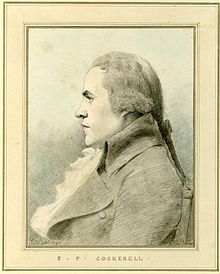Samuel Pepys Cockerell | |
|---|---|
 | |
| Born | 15 February 1754 |
| Died | 12 July 1827 (aged 73) |
| Nationality | British |
| Occupation | Architect |
| Spouse |
Anne Whetham (m. 1782) |
| Children | 11, including Charles |
| Buildings | Sezincote House |
| Projects | Bayswater |
Samuel Pepys Cockerell (15 February 1753 – 12 July 1827)[1] was an English architect.
He was a son of John Cockerell, of Bishop's Hull, Somerset, and the elder brother of Sir Charles Cockerell, 1st Baronet, for whom he designed the house he is best known for, Sezincote House, Gloucestershire, the uniquely Orientalising features of which inspired the more extravagant Brighton Pavilion.[2][3][4][5] He was a great-great nephew of the diarist Samuel Pepys.
- ^ Howard Colvin, A Biographical Dictionary of British Architects, 1600–1840, 3rd ed. 1995, s.v. "Cockerell, Samuel Pepys".
- ^ John Betjeman, "Sezincote, Moreton-in-Marsh, Gloucestershire", Architectural Review 69 (May 1931:161–66)
- ^ Christopher Hussey, "Sezincote", Country Life, 85, 13 May and 20 May 1939
- ^ Edward Malins, "Indian Influences on English Houses and Gardens at the Beginning of the Nineteenth Century" Garden History 8.1 (Spring 1980:46–66)
- ^ Howard Colvin, A Biographical Dictionary of British Architects, 1600–1840, 3rd ed. 1995, s.v. "Cockerell, Samuel Pepys".